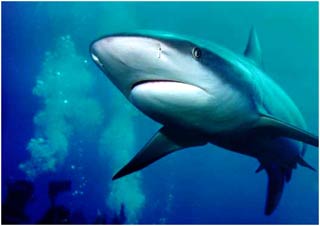Which does shark use to locate smell?
Sharks are known to have very good sense of smell, which is very important for finding food in many species. However, according to a new study from Boston University marine biologists, sharks cannot use each of their noses to locate prey, but they need to rely on their own skin - especially in the third row.
The lateral line is a part of all fish used to detect, by subtle sensitivity, movements and vibrations in the water around them. According to the team, this is similar to the way people perceive airflow with tiny hairs on their faces. But until now, it has not been proven that the third row also helps fishes find smells.
'Smells are a complex and powerful 3-dimensional structure used by many animals to determine the location of food, partners, and whereabouts. However, the scent does not have orientation properties so animals must use a variety of senses to get directional information for a particular odor, ' said Jelle Atema, professor of biology at the university. Boston and co-author of this study, said.
 This new study examines the contribution of the olfactory system, the third and visual scales in locating and detecting where the smell is found in shark. The results of the study, published in the June 1 issue of Experimental Biology , have shown that this shark has a great defect in its ability to locate the source of odor when there is not enough information received from their third scales, especially in the dark .
This new study examines the contribution of the olfactory system, the third and visual scales in locating and detecting where the smell is found in shark. The results of the study, published in the June 1 issue of Experimental Biology , have shown that this shark has a great defect in its ability to locate the source of odor when there is not enough information received from their third scales, especially in the dark .
According to Atenma, because most odors disperse the scent according to each array, fish locating odor sources through a so-called ' whirlpool movement ' means to detect odor and vibrations in the water together. a time.
'We can see the smell and turbulence in the oil-filled waterway behind a boat. Similarly, a moving animal will leave traces of whirlpools that carry the smell of its body, ' explained Atema.
In the 8-meter-long gutter in the laboratory, Atema and Jayne Gardiner created two lines of scent with strong parallel water - a trough using the smell of squid and the other is odorless seawater. Sources of ' leaks ' of squid and odorless seawater with light flowing water are separated from strong flowing water by placing a brick in the direction of the flow of water at each source of the odor to create two The waterway flows sharply with one of the two roads, one or the other, smelling food. This creates four separate ' goals ' for sharks to locate.
'In addition, we examined sharks in two conditions of light - fluorescence and infrared - and in two sensory conditions - with their third rows intact or damaged by streptomycin. , Mrs. Gardiner explained.
According to the researchers, streptomycin is an antibiotic that interferes with the normal function of sensitive 'hair cells' or sensory cells of the third scale . In high doses, it also causes hearing and balance problems in humans, senses that are also based on hair cells.
Sharks with intact third row of scales give priority to the smell of squid rather than an odorless seawater, and more specifically to give preference to odor sources with a stronger flow of water than The source has only one odor. Priority for odor flow and target search time is not much affected by lighting conditions.
In light, compromised third rows increase the search time but do not affect the success rate or preference for odor flow. However, these damaged fish are unable to distinguish between the odor source with strong flowing water and only one source. In the dark, the search time of the fish damaged by the third scale also increased and very few fish were able to locate one of the targets and they could not distinguish between the smell of the ink. the pipes and seawater are odorless, let alone locate the target.
'These results show that sharks need to use both the olfactory and the third scales to search for the correct and successful odors of water and the help of visual organs can improve. finding food when there is no information from the 3rd row, ' said Atema. These results are interesting. They help us understand the orientation of underwater fish species and help develop methods for creating underwater underwater vehicles.
Thanh Van
- Decode the shark's super sense of smell
- Warning of fake shark microbes, made of plastic
- Detecting sharks can be driven by the nose
- Big sharks eat small sharks
- People smell 10 kinds of smell
- The first shark in history to know ... vegetarian but still healthy
- Interesting revelations about smell and smell
- Discover a new smell
- Catch sharks from prehistoric times
- Install a super-sensitive camera on the shark's body
- This man knows the smell of red green
- Catch a shark with a body like a snake, a mouth of 300 teeth
 Surprised: Fish that live in the dark ocean still see colors
Surprised: Fish that live in the dark ocean still see colors Japan suddenly caught the creature that caused the earthquake in the legend
Japan suddenly caught the creature that caused the earthquake in the legend A series of gray whale carcasses washed ashore on California's coast
A series of gray whale carcasses washed ashore on California's coast Compare the size of shark species in the world
Compare the size of shark species in the world